Homelessness has risen in America since 2017 due to several factors, like rising housing prices and the rising cost of living.
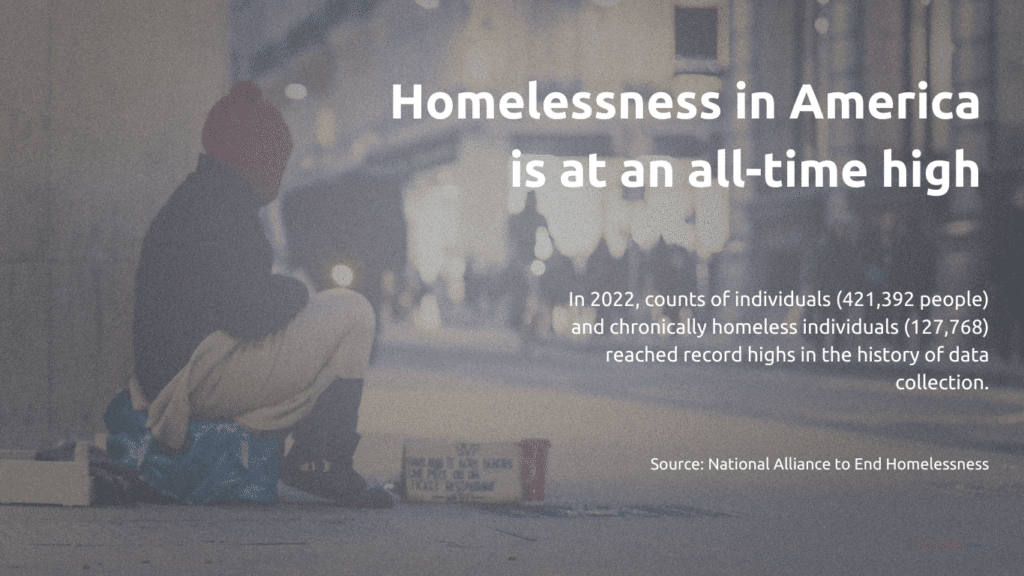
Californians have the highest likelihood of being unhoused, with 44 out of every 10,000 residents being homeless. Residents in major cities with high housing costs also have a higher chance of homelessness, such as New York City, Boston, Washington D.C., Seattle, and Los Angeles.
Implementing creative solutions to solve this problem is essential for the health of many American cities and towns. Several solutions are geared toward the housing affordability crisis. And experts say the answer is always “housing first,” meaning finding permanent housing solutions is the best way.
Some organizations helping to end homelessness include many you may know, like Habitat for Humanity. However, many other U.S. nonprofits are trying novel ideas to end homelessness.
This resource guide will give you an overview of the innovative ideas some nonprofits are trying to end homelessness.
Innovative Solutions for Affordable Housing & Ending Homelessness
Tiny Homes: A Promising Component

Building tiny emergency shelters is one homelessness solution that has emerged in recent years.
Why tiny homes?
Tiny homes have become a popular solution for several reasons. They usually work better than traditional homeless shelters, and they tend to offer more services, such as regular, one-on-one access to case managers. This also makes tiny homes much more expensive to operate.
Tiny home experiments
Based in Long Beach, California, The Tiny House Project is a nonprofit doing just this. Many elected officials have been eager to use this creative solution and build “tiny home villages,” and proposals for them have sprung up in communities across the country.
Experts say:
While the idea is a start, not everyone is entirely on board. And more than likely, tiny homes for the homeless play only a small part in helping people find permanent housing solutions. The National Alliance to End Homelessness suggests tiny homes should be only one part of a broader strategy to place individuals in permanent, affordable housing.
“Tiny Homes could be part of the mix – but they are not the solution. Any investment in them requires serious strategic considerations,” the National Alliance to End Homelessness says on its website. “Despite their potential, we must strive to create permanent, affordable housing options and avoid anything that creates substandard or segregated housing for people experiencing homelessness.”
Research from the USC Annenberg Center for Health Journalism has also shown tiny homes don’t work as intended for most participants. People moving out of tiny homes in Alameda County, California, failed to find permanent housing about 75% of the time between June 2019 and June 2022. In Santa Clara County, people leaving tiny homes didn’t find permanent housing more than 50% of the time.
Organizations building tiny homes for the homeless:
3D Homes for the Homeless
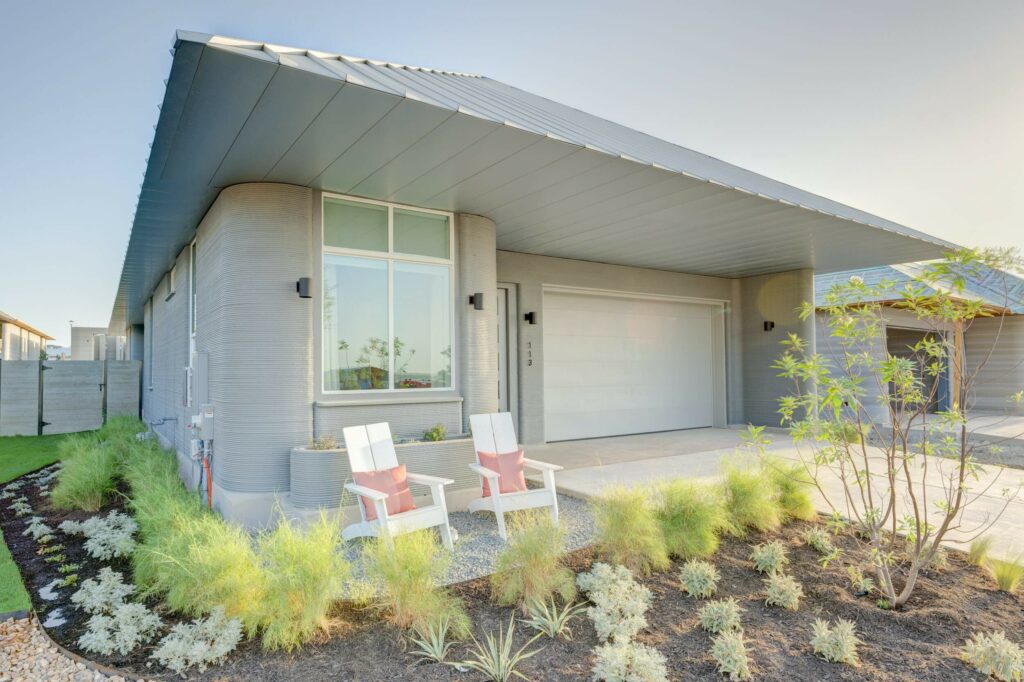
A new technology that could help alleviate homelessness is 3D printers.
Why 3D-printed homes?
A 3D printer can print three houses at once and complete the walls for a home in about 24 hours.
3D-printed home experiments
Several construction companies nationwide are experimenting with the tech to construct tiny homes for people without housing, including a company called Icon. Icon is partnering with Austin, Texas’ Community First nonprofit to build six homes in a tiny home village.
The Austin village has space for 180 residents who live in 200-square-foot homes where they pay $300 in rent and have job opportunities onsite.
The technology is also being used by two new California companies, Emergent 3D and Mighty Buildings. They plan to use 3D printing to help families displaced by wildfires and address California’s housing crisis.
Experts say:
3D homes are a promising solution, but like tiny home villages, most experts see them as “interim housing” and not a permanent solution. The National Alliance to End Homelessness conducted a focus group with people with lived experience of homelessness, and most said permanent housing is the ultimate goal and where funding resources should be allocated to the most.
However, interim solutions like tiny home villages, 3D home villages, and converting unused hotels, schools, and other buildings into interim housing should also be part of the funding mix.
Read more:
- How 3D printed houses are helping the homeless – Stand Together
- Homelessness could have a 3D-printed solution – Route Fifty
- Around The Corner: 3D Housing Designed For The Homeless And Needy Seniors – KFF Health News
- Future Aspirations: Could 3D Printing End Homelessness? – Invisible People
Turning Shipping Containers Into Homes

Modular construction is one technique to build needed housing quickly.
Why shipping containers?
Modular housing isn’t cheaper than traditional construction, but the advantage is it can be done much faster. It takes three shipping containers to make a one-bedroom apartment and two containers for a studio.
Shipping container home experiments
One nonprofit housing developer, People Assisting the Homeless (PATH), is partnering with CRATE to build an affordable housing project in San Diego by converting upcycled shipping containers into apartments. CRATE also worked with American Family Housing to build Potter’s Lane in Orange County, a permanent multi-housing solution for homeless veterans utilizing recycled shipping containers.
The shipping containers are converted into studio and one-bedroom apartment units, where homeless or low-income people can be housed for low rents (about $300 monthly). Similar ideas are turning old buses into housing, as one company has done in London, or converting vacant office buildings into housing.
Experts say:
Shipping containers converted into homes comes with several benefits, according to experts, such as durability and strength, fast construction, mobility, and unique designs. But there are downsides, too. The supply chain mess caused by the pandemic means there’s still a limited supply of containers out there.
A typical shipping container converted into housing also has limited space inside as a dwelling option; they can become extremely warm in the summer months, and there’s a possibility of health hazards from chemicals and paint.
Last but not least, zoning and permitting can be complicated for a shipping container converted into housing. Since this is a new trend, most cities don’t have specific rules in place for them, which could result in a longer zoning and permitting process.
Each city will also have its own building code requirements that must be met, such as fitting the containers for emergency access, alarms, plumbing, and energy efficiency. Bottom line: Shipping containers converted into housing can work as a solution, but it’s more complicated than some think.
Read more:
- This Innovative Solution is Housing Homeless Families – Goodnet
- Pros And Cons of Shipping Container Homes – BigSteelBox
- Newark is transforming more shipping containers into homes for homeless people – Gothamist
- Shipping containers used to build LA housing complex for the homeless – dezeen
Safe Parking RV Parks

Providing permanent housing is the ultimate goal of ending homelessness. But another short-term solution is providing safe spaces. Some cities are providing safe spaces for RV parks, similar to setting aside land for encampments.
Why safe parking RV parks?
Research from UC San Diego found that homeless people who live in their vehicles strongly favor parking lots that are open 24 hours. It makes life easier for unhoused people because they don’t have to worry about parking their cars or RVs illegally and having them ticketed or towed. Safe RV parks also usually provide access to services and case workers for those parked there.
Safe Parking Experiments
San Jose, California, is one city that has provided a safe RV parking site for 42 homeless individuals living in their vehicles. The 115,000-square-foot site is leased by the city and operated by a nonprofit called LifeMoves, which provides housing and support services to people temporarily living there.
Water, handwashing stations, and porta-potties are accessible at the parking site, and people can use their generators for power. Mobile showers are provided once or twice weekly, and garbage and recycling are picked up weekly.
Seattle, San Diego, and Portland are other cities that have set up safe parking sites for people experiencing homelessness. Some encampments, such as in Portland, have been controversial for various reasons, including being blamed for physical assaults on residents.
Experts say:
Homeless advocates acknowledge the sites are only a short-term solution, but they can help connect people with support services while looking for permanent housing. Oftentimes, RVs and cars are also the only tangible assets that some homeless individuals have, so allowing them to keep them and park them in safe spaces without fear of being towed is seen as a big plus.
There are drawbacks, though, according to experts. For one, creating these safe parking spaces isn’t cheap. The city of Seattle spent nearly $2 million to create safe parking areas as part of its homeless action plan in 2022.
Pushback from residents near safe parking sites can also derail these projects. Residents in one San Jose neighborhood fought back against one such site in 2021 after saying there was a lack of transparency about choosing a site so close to them and questioning whether the city would hire more security to monitor the area.
Read more:
- Safe Parking Program – City of Santa Rosa, California
- What’s life like in a 24/7 safe parking lot for homeless? ‘This isn’t an RV camp’ – San Deigo Union-Tribune
- A Primer on Safe Parking Programs for People Experiencing Homelessness – MRSC
- Safe Parking – Mountain View, California
Managing Encampments more Humanely
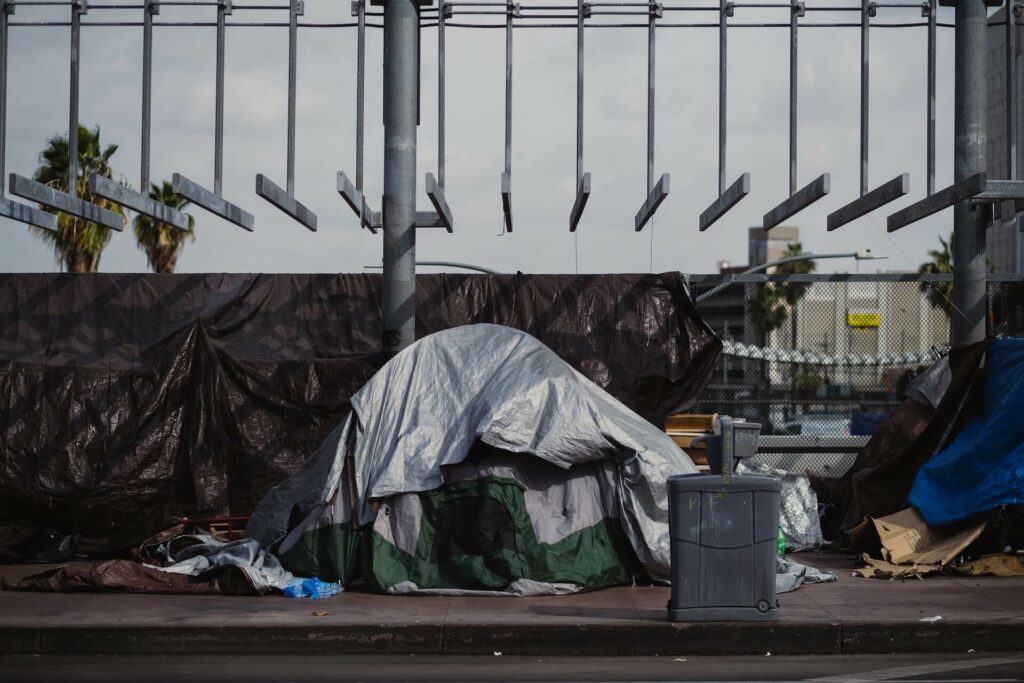
A controversial aspect of homelessness in many cities is encampments, which have become common from Los Angeles to Philadelphia. A short-term solution for some cities has been to smartly manage these encampments and set aside land for homeless persons to use safely.
How to manage encampments?
After seeing more people sleeping outside, the city of Olympia, Washington, established a safe area for homeless people downtown in 2018. It’s not intended as a long-term solution, but it helps the immediate needs of homeless people.
Olympia’s homeless encampment doesn’t require people to part with their belongings or pass sobriety tests. The space provides homeless people an area to stay who want to remain close to downtown and the resources there. It’s safer than under bridges or overpasses, giving city officials more time to develop a more comprehensive solution.
A better solution in Los Angeles
Setting aside land and smartly managing encampments is one strategy, but the National Alliance for Ending Homelessness suggests a better way. More than 200 people lived in tents along the Venice boardwalk in Los Angeles at one time before a coordinated effort between the city and nonprofits.
Now, nearly 90% of the people living in the tents have been matched to a permanent housing resource. St. Joseph Center, with the help of local officials, convinced people living on the boardwalk to move into better conditions, even if it was an interim housing solution. The trust and good faith between the unhoused population and the officials were essential because people moved away from encampments are sometimes re-traumatized by more aggressive efforts by law enforcement and other officials.
Experts say:
The efforts of cities like Olympia, Washington, in providing a safe space for the homeless and smartly managing encampments are laudable but misguided. Encampments create public health dangers because of crowded living conditions, lack of access to proper waste disposal, and poor hygiene.
However, experts say encampments shouldn’t just be dismantled and push the residents to other parts of a community without a solution. As the example in Los Angeles shows, residents of encampments need to be connected with resources to permanent or at least interim housing – instead of shuffled somewhere else.
A coordinated response between non-profit agencies and city officials that helps encampment dwellers connect with case workers and find a path to more permanent housing is a more humane and effective way to deal with the issue.
Read more:
- There’s a Right Way and a Wrong Way to Address Encampments – National Alliance to End Homelessness
- An Overview of Homeless Encampments – National League of Cities
- Best Practices for Addressing Street Encampments – Los Angeles Homeless Services Authority
- 7 Principles for Addressing Encampments – United States Interagency Council on Homelessness
- Responding to Homeless Encampments: Strategies and Costs – Center for Evidence-Based Solutions to Homelessness
Optimized Homeless Shelters

Emergency homeless shelters often play a critical, life-saving role to providing a safe place for people living on the streets. However, experts note that providing shelter beds alone is often a temporary, inadequate fix to solving homelessness.
How to improve homeless shelters?
Some communities have switched their model from sheltering people overnight with late entry and early exit to providing a temporary place for someone to stay 24/7. This enables the unhoused to store their belongings, access employment services and healthcare, and more quickly move to permanent housing.
San Francisco is testing this model with its Navigation Center. City officials find that people who are living in encampments are more willing to come to shelters when they are allowed to come as they are, and it may lead to something better – and not just a temporary place to stay before being kicked back onto the streets.
A solution in New Jersey
New Jersey’s most populated county, Bergen County, was certified in 2017 as the first in America to end chronic homelessness. How did they do it? Partly through a foundation built as a one-stop center for housing, health, and human services that opened in 2019.
The center helps people who are homeless, precariously housed, and in need of connection to community services. It runs 24 hours daily and provides temporary shelter, meals, wellness programs, and, perhaps most importantly, housing placement.
The housing placement component offers guests support to transition to permanent rental housing. Bergen County, in particular, utilizes a system to assess those in need of housing resources — those “experiencing chronic homlessness are prioritized for permanent supportive housing,… while those with lesser needs are connected to effective lower cost options.”
The center is a big reason why Bergen County has reduced homelessness. In 2019, the county showed a 23% decrease in people experiencing homelessness, amounting to 83 fewer people. It’s a joint project between the County of Bergen and the Housing Authority of Bergen County.
Government officials run the all-in-one center, unlike a nonprofit and other solutions we’ve discussed. But it’s something other cities and counties can emulate and also a place where people can volunteer.
Experts say:
The National Alliance to End Homelessness says emergency shelters, like many of the solutions we’ve discussed, should be just one part of a strategy to find people permanent housing. However, there are ways to improve emergency shelters to ensure they are the most effective as possible.
For example, if the shelter’s utilization rates are lower than 95%, it’s possible that restrictive rules or unfit conditions are preventing people from using it. Communities can survey people living on the street and those using the shelter to determine what’s affecting their reluctance to use it.
Experts also say it’s essential to create a more coordinated response that provides pathways to permanent housing – so that shelters aren’t a dead-end and accessing services isn’t a bureaucratic maze. Emergency shelters that are part of a broader network and plan in each community that connects the unhoused with an array of services – such as the one in Bergen County, New Jersey – are the ones that are the most effective.
Read more:
- Bergen County Housing, Health & Human Services Center
- Using Shelters Strategically to End Homelessness – United States Interagency Council on Homelessness
- Would Adding More Emergency Shelter Help Reduce Unsheltered Homelessness? It’s Complicated … – National Council to End Homelessness
- How Communities Are Improving Their Homeless Services Capacity – HUD User
Overview of National Organizations Working to End Homelessness
Habitat for Humanity is the most well-known nonprofit involved in building housing for underserved communities. Habitat homeowners help build their own homes alongside volunteers and are assisted in paying an affordable mortgage.
Habitat for Humanity is a global organization working in local communities in all 50 U.S. states and over 70 countries. Millard and Linda Fuller founded the now-famous organization in the United States in 1976 after establishing a similar program over three years in Zaire.
The Fuller Center for Housing is another nonprofit in the housing field that seeks to eradicate poverty housing by promoting partnerships with individuals and community groups to build and refurbish homes for people in need. Founded in 2005, the nonprofit’s international headquarters is in Americus, Georgia, and it is currently operating in 70 U.S. communities and 20 countries.
Building Homes for Heroes is a housing nonprofit founded after 9/11 that builds or modifies homes and gifts them, mortgage-free, to injured veterans and their families. The nonprofit also provides support services to these veterans to help them build better and brighter lives. Since its founding, Building Homes for Heroes has gifted more than 300 homes to America’s injured veterans.
Homes for Our Troops is a housing nonprofit dedicated to building and donating custom homes nationwide for severely injured post-9/11 veterans. Since 2004, HFOT has built more than 360 homes for veterans nationwide. The nonprofit stays in contact with veterans after home delivery, providing pro-bono financial planners for three years to assist in financial planning and household budgeting. HFOT also provides homeownership education and warranty coverage to ensure the veterans are set up for long-term success.
Many other nonprofits operate on a regional level and help with homelessness outreach, affordable housing assistance, or building homes for underserved populations.
Below is a chart of some of the better-known nonprofit organizations doing so in major U.S. metropolitan areas:
Homelessness in America, By the Numbers
Homeless Statistics by States & Cities
The number of homeless nationwide fluctuates and constantly changes, so comprehensive figures are hard to find. However, one 2022 study found that differences in per capita homelessness rates across the U.S. aren’t due to mental illness, drug addiction, or poverty but because of differences in housing.
Therefore, West Coast cities like Seattle, Los Angeles, Portland, and San Francisco have homelessness rates five times that of areas with much lower housing costs, like Arkansas and West Virginia, even though the latter locations have higher rates of poverty and drug addiction.
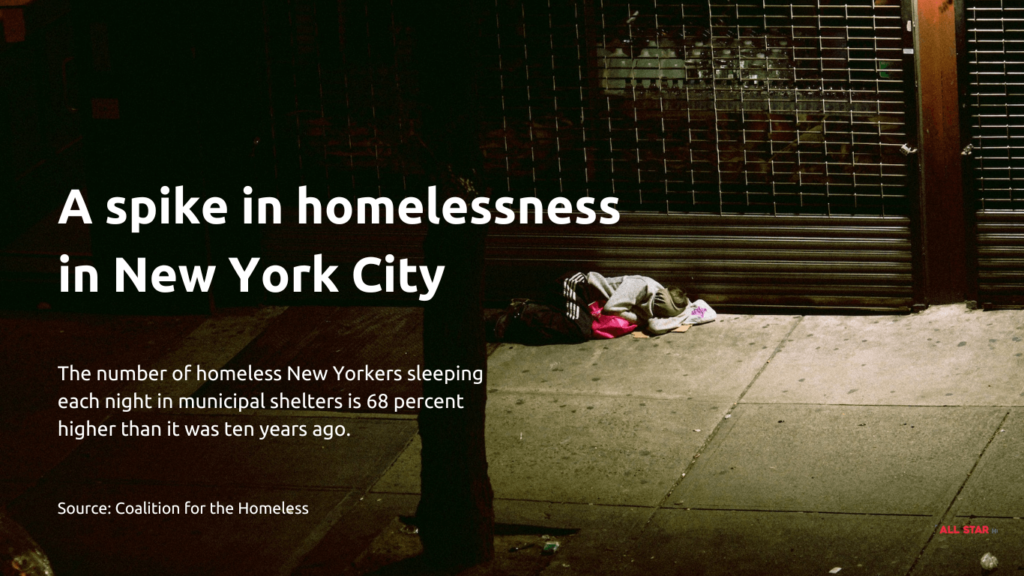
When it comes to homelessness, California is by far the state where people suffer the most. Part of this is because of how expensive housing is in the Golden State and the generally high cost of living. Los Angeles city and county had the highest population of homeless people in 2022 (more than 65,000), followed closely by New York City, another large metro with high housing costs.
Homelessness in U.S. Cities and States:
- 30% Homeless in California. As of 2022, 30% of all people in the United States experiencing homelessness resided in California.
- Unsheltered in Oregon. Oregon has the nation’s highest percentage of homeless families that are living completely unsheltered – meaning they aren’t sleeping in a shelter, hotel, or other temporary housing while experiencing homelessness.
- 1 in every 83 New Yorkers are homeless. In a city of more than 8.3 million people, nearly one in every 83 New Yorkers is homeless — that's more than 100,000 men, women and children.
- 23% increase in homelessness in Arizona. Homelessness across the country increased by less than 1% between 2020 and 2022, the report showed. Yet Arizona saw a 23% jump in its homeless population.
- Young and homeless in AZ. A report from the Department of Housing and Urban Development said 284 unaccompanied youth under age 25 were added to the rolls of homeless people in Arizona between 2020 and 2022, bringing the total in the state to 917.
Homelessness Health and Mortality Stats
It’s evident that homeless individuals are likely to die faster. The consequences of being homeless on health are numerous, and non-elderly people who have experienced homelessness face 3.5 times higher mortality risk than people with adequate housing. The disparity between people who are housed and those who are not is striking. Some statistics about this disparity show why ending homelessness is such a priority in the United States.
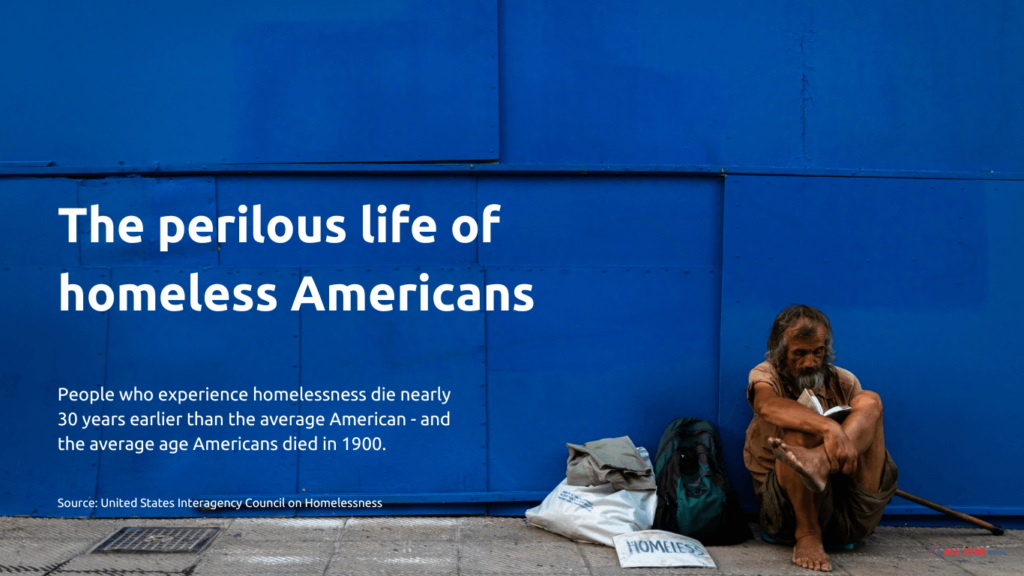
Health and Mortality Statistics for the Homeless:
- The homeless mortality gap. The mortality disparity between housed and unhoused far exceeds the mortality gap between Black and white-housed individuals (1.4) and between poor-housed and all-housed individuals (2.2).
- 60% greater mortality for homeless people than for poverty. Homelessness is associated with a 60 percent greater mortality risk than poverty alone.
- A vast and largely hidden problem. An estimate of 5,800-46,500 deaths among people experiencing homelessness per year by the National Health Care for the Homeless Council highlights the vast and largely hidden scale of homeless deaths in the U.S.
- The homeless death toll is rising. An examination of 20 U.S. urban areas by The Guardian and an academic expert at The University of Washington found the number of deaths among people living without housing shot up by 77% in the five years ending in 2020.
- The homeless die way too young. An unhoused person who is 40 years old has a similar mortality risk to a 60-year-old with housing or a 50-year-old poor person with housing, according to research from The University of Chicago.
Youth Homeless Statistics
Perhaps the most heartbreaking of all aspects of homelessness in America is the number of homeless young people. Every year, an estimated 4.2 million youth and young adults experience homelessness in the U.S., 700,000 of which are unaccompanied minors, meaning they’re not with a family.
Based on these estimates, about one in 10 adults ages 18 to 25 and one in 30 youth ages 13 to 17 will experience homelessness in America each year. Experts note this is likely an undercount due to varying definitions of homelessness and challenges with contacting unhoused people, especially youth.
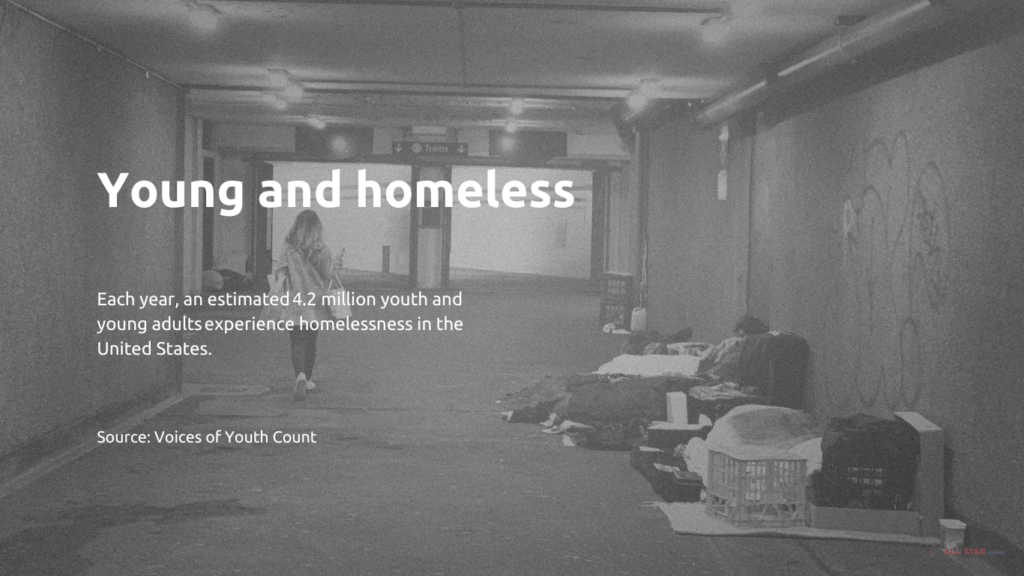
Youth and Homelessness Statistics:
- Chronic homelessness among young Americans. 42% of all young people who experience homelessness do so more than once.
- A vulnerable youth population. LGBTQ+ youth are 120% more likely to experience homelessness than their peers.
- Young, homeless, and alone. On any given night, approximately 41,000 unaccompanied youth ages 13-25 experience homelessness.
- The #1 indicator of youth homelessness. The lack of a high school diploma or General Equivalency Diploma (GED) is the number one correlate for elevated risk of youth homelessness.
- Mental illness and youth homelessness. 69% of homeless youth report mental health problems.










